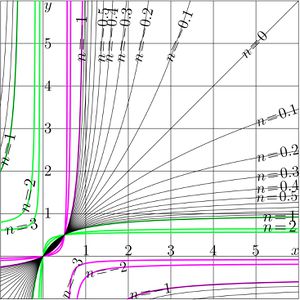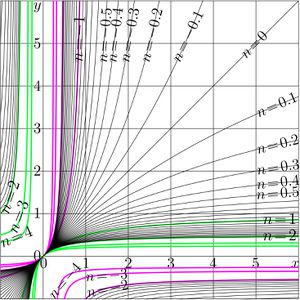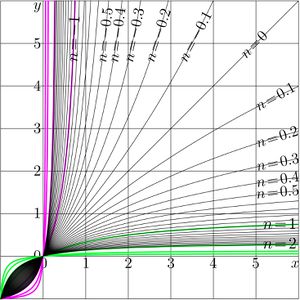Difference between revisions of "Iterate of linear fraction"
(→Generalization) |
((0)) |
||
| Line 3: | Line 3: | ||
[[File:Fracit20t150.jpg|300px|thumb|$\displaystyle f(z)=\frac{z}{2+z} ~$; plot of $y=f^n(x)$ versus $x$ for various $n$]] |
[[File:Fracit20t150.jpg|300px|thumb|$\displaystyle f(z)=\frac{z}{2+z} ~$; plot of $y=f^n(x)$ versus $x$ for various $n$]] |
||
Iterate of linear fraction (or iteration of linnet friaciton) refers to function |
Iterate of linear fraction (or iteration of linnet friaciton) refers to function |
||
| − | ( |
+ | (01)$~ ~ ~ \displaystyle T(z)=\frac{u+vz}{w+z}$ |
[[Iterate]] of a [[linear fraction]] can be expressed with also some linear fraction. This article describes this expression. |
[[Iterate]] of a [[linear fraction]] can be expressed with also some linear fraction. This article describes this expression. |
||
| Line 9: | Line 9: | ||
==Special case== |
==Special case== |
||
First, consider the special case when the iterated function has only single parameter. Let |
First, consider the special case when the iterated function has only single parameter. Let |
||
| − | ( |
+ | (02) $~ ~ ~ \displaystyle t(z)=\frac{z}{c+z}$ |
where $c\ne 0$ is constant; for example, the [[real number|real]] or [[complex number]]. |
where $c\ne 0$ is constant; for example, the [[real number|real]] or [[complex number]]. |
||
| Line 16: | Line 16: | ||
$t^{m+n}(z)=t^m(t^n(z))$ |
$t^{m+n}(z)=t^m(t^n(z))$ |
||
For $c\ne 1$, the simple solution can be written as follows: |
For $c\ne 1$, the simple solution can be written as follows: |
||
| − | ( |
+ | (03) $~ ~ ~ \displaystyle t^n(z)=\frac{z}{c^n+ \frac{1-c^n}{1-c} z }$ |
==Limiting case== |
==Limiting case== |
||
| Line 22: | Line 22: | ||
can be written as follows: |
can be written as follows: |
||
| − | ( |
+ | (04) $~ ~ ~ \displaystyle t^n(z)= $ |
$\displaystyle\lim_{c\rightarrow 1} $ |
$\displaystyle\lim_{c\rightarrow 1} $ |
||
$\displaystyle\frac{z}{c^n+ \frac{1-c^n}{1-c} z }=$ |
$\displaystyle\frac{z}{c^n+ \frac{1-c^n}{1-c} z }=$ |
||
Revision as of 16:54, 17 August 2013
Iterate of linear fraction (or iteration of linnet friaciton) refers to function
(01)$~ ~ ~ \displaystyle T(z)=\frac{u+vz}{w+z}$
Iterate of a linear fraction can be expressed with also some linear fraction. This article describes this expression.
Contents
Special case
First, consider the special case when the iterated function has only single parameter. Let
(02) $~ ~ ~ \displaystyle t(z)=\frac{z}{c+z}$
where $c\ne 0$ is constant; for example, the real or complex number.
The iterate $t^n$ should satisfy the following equations:
$t^1(z)=t(z)$
$t^{m+n}(z)=t^m(t^n(z))$
For $c\ne 1$, the simple solution can be written as follows:
(03) $~ ~ ~ \displaystyle t^n(z)=\frac{z}{c^n+ \frac{1-c^n}{1-c} z }$
Limiting case
At $c=1$. The expression of the previous section cannot be applied as is. For this case, the $n$ th iteration of function $t(z)=\frac{z}{1+z}$ can be written as follows:
(04) $~ ~ ~ \displaystyle t^n(z)= $ $\displaystyle\lim_{c\rightarrow 1} $ $\displaystyle\frac{z}{c^n+ \frac{1-c^n}{1-c} z }=$ $\displaystyle\frac{z}{\displaystyle\lim_{s\rightarrow 0}\left( (1\!-\!s)^n + \frac{1-(1-s)^n}{s} z \right)}=$ $\displaystyle\frac{z}{1+nz}$
One can see that this expression satisfies equations
$ t^{n+1}(z)=t(t^n(z))=t^n(t(z))$
Generalization
Consider linear function $P$, let
(05) $~ ~ ~ \displaystyle P(z)=A + B z$
The inverse function can be written as follows:
(06) $~ ~ ~ \displaystyle Q(z)=P^{-1}(z)=\frac{x-A}{B}$
One can easy check that $P(Q(z))=Q(P(z))=z$. Let
(07) $~ ~ ~ \displaystyle T(z)=P(t(Q(z)))= \frac{ABc - AB - A^2 ~+~ (A\!+\!B)z}{Bc-A+z}$
This agree with equation (1) at
(08) $~ ~ ~ \displaystyle u=ABc-AB-A^2$ (09) $~ ~ ~ \displaystyle v=A+B$ (10) $~ ~ ~ \displaystyle w=Bc-A$
It is possible to express $A,B,c$ in terms of $u,v,w$:
(11) $~ ~ ~ \displaystyle A=\frac{v-w-R}{2}$
(12) $~ ~ ~ \displaystyle B=\frac{v+w+R}{2}$
(13) $~ ~ ~\displaystyle c=\frac{-2 u - v^2 - w^2 +(v+w)R}{2(u-vw)}$
where
(14) $~ ~ ~ \displaystyle R= \sqrt{4 u + v^2 - 2 v w + w^2}=2r=2\sqrt{u+\left(\frac{v-w}{2}\right)^2}$
In principle, it is possible to choose $R$ to be negative of the square root above. However, for the application in evaluation of the non-integer iterate, it is convenient to keep the coefficient $B$ positive, at least for positive $u,v,w$, in a wide range of their variation. In particular, the interpretation of transform $P$ is easier, while $P'(z)>0$.
Non-integer iterate
As function $g$ is expressed through conjugation of function $f$, the iteration can be expressed as follows:
$g^n(z)=P(f^n(Q(z))$
All functions $P$, $f^n$ and $Q$ are defined above, and $f^n$ is expressed in a way, that does not require the number $n$ of iteration to be integer.
In such a way, the linear fraction can be iterated any number of times, the halfiteration and the complex iterations are straightforward. In Mathematica, this could be expressed with the built-in function Nest, but, up to year 2013, the software does not yet allow to use it for non-integer number of iterate; if the number of iterations cannot be expressed with some positive integer constant, Mathematica generates the error message instead of to evaluate the expression.
Superfunction
The nth iteration of function $f$ can be used to express the superfunction for the linear fraction; if $f$ is declared as transfer function, then, for some constant $t$, the superfunciton $F$ can be written as follows:
$ F(z)=f^z(t)$
and the interse function $G=F^-1$ appears as the Abel function.
Linear fraction is one of transfer functions, for which the superfunction and the Abel function can be expressed in terms of elementary functions. For many cases, instead of to express the superfunction through the iterate of the transfer function, function, contrary, the iterate of the transfer function is experessed through the superfunction $F$ and the Abel function $G$ with
$f^n(z)=F(n+G(z))$
References
http://www.ams.org/journals/bull/1993-29-02/S0273-0979-1993-00432-4/S0273-0979-1993-00432-4.pdf Walter Bergweiler. Iteration of meromorphic functions. Bull. Amer. Math. Soc. 29 (1993), 151-188.
http://www.ams.org/mcom/2009-78-267/S0025-5718-09-02188-7/home.html
http://www.ils.uec.ac.jp/~dima/PAPERS/2009analuxpRepri.pdf
http://mizugadro.mydns.jp/PAPERS/2009analuxpRepri.pdf
D. Kouznetsov. Solution of F(x+1)=exp(F(x)) in complex z-plane. 78, (2009), 1647-1670
http://www.ils.uec.ac.jp.jp/~dima/PAPERS/2009vladie.pdf (English)
http://mizugadro.mydns.jp/PAPERS/2010vladie.pdf (English)
http://mizugadro.mydns.jp/PAPERS/2009vladir.pdf (Russian version)
D.Kouznetsov. Superexponential as special function. Vladikavkaz Mathematical Journal, 2010, v.12, issue 2, p.31-45.
http://reference.wolfram.com/mathematica/ref/Nest.html Nest, Wolfram Mathematica 9 Documentation center, 2013.


